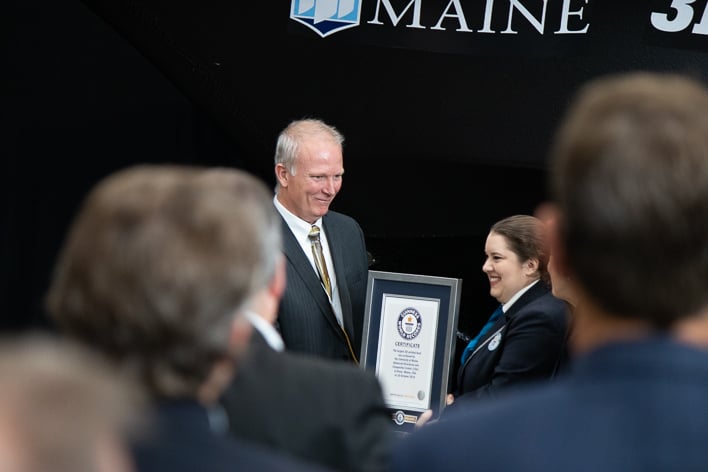Watch The World's Largest 3D Printer In Action At UMaine
3D printing has increased in popularity over the last few years. These printers have been used in a wide variety of environments, including classrooms, labs, and homes. Many are now looking to 3D printing for industrial purposes, and these kinds of projects require a massive printer and a large amount of resources. One university may be able to provide all the necessary products for large scale 3D printing -- The University of Maine -- which just unveiled the world’s largest 3D printer.
The boat was christened 3Dirigo, in honor of Maine's state motto. They have also printed a boat mold that can be used by other boat builders. In total, the University earned three world records this week. These were awarded for the largest polymer 3D printer in the world, the largest polymer 3D printed boat in the world, and the largest polymer 3D printed object in the world.
3D printing, or “additive manufacturing”, creates three dimensional objects by adding layers of plastic filaments. The University has developed its own filament from cellulose nanofiber (CNF), or a tree that has essentially been ground down to its nano structure. The CNF is then combined with polylactic acid to create a strong, plastic polymer pellet. This particular 3D printer can consume up to 500 pounds of pellets per hour, and 3Dirigo was printed in just over a weekend's time.
This new 3D printer is part of a collaboration between the University of Maine and the United States Department of Energy’s Oak Ridge National Laboratory in Oak Ridge, Tennessee. The Oak Ridge National Laboratory has its own 3D printer, but the University of Maine’s device dwarfs it. Oak Ridge National Laboratory held the previous record for largest polymer 3D printed object, at 1600 pounds. The two institutions received $20 million USD in federal funds to research “large-scale biobased additive manufacturing.” They hope to develop new, recyclable materials and enable “rapid prototyping of large civilian and defense platforms.”
Senators Susan Collins and Angus King as well as Representative Jared Golden participated in the unveiling. Senator Collins had the honor of christening the boat 3Dirigo with a bottle of champagne. Senator Collins stated "the future of the Composites Center is truly gamechanging...that will support the next generation large-scale additive manufacturing with biobased thermoplastics." The three leaders joined University of Maine President, Joan Ferrini Mundy, and University of Maine System Chancellor, Dan Malloy, and the executive director of the Composites Center, Habib Dagher, on 3Dirigo's "maiden voyage" in the University's 30-meter wind-wave pool.
The research could also potentially benefit Maine’s economy. Representative Golden added, "There's always been a relationship between scientific advancement, economic growth, and strategic change" in support of the 3D printer's impact on Maine's economic growth and national defense. Maine was once the home of numerous paper mills, but many of these have closed over the last two decades. Researchers, politicians, and everyday citizens have been looking for new ways to take advantage of Maine’s forest industry. The printer’s plastic filament is comprised of 50% wood, so it may help to revitalize this particular economy. Senator Angus King remarked that Maine's three greatest resources are "its forest, its oceans, and its people." Researchers also believe that the printer could impact other industries. For example, the boat mold could potentially speed up the time it takes to build a boat, reduce costs, and encourage sustainability.
The capabilities of 3D printing are truly remarkable. Scientists recently printed a human heart from a patient’s cells. The heart included cells, blood vessels, ventricles, and chambers. Unfortunately the heart was too small to be transplanted into the patient, but scientists are hopeful that they will be able to do this within the next decade. Professor Tal Dvir of Tel Aviv University’s School of Molecular Cell Biology and Biotechnology, remarked, “Our results demonstrate the potential of our approach for engineering personalized tissue and organ replacement in the future.” Whether it be a boat mold or a heart, the potential for 3D printing right now seems nearly boundless. It will be interesting to see how the University of Maine uses their new printer in the future.







